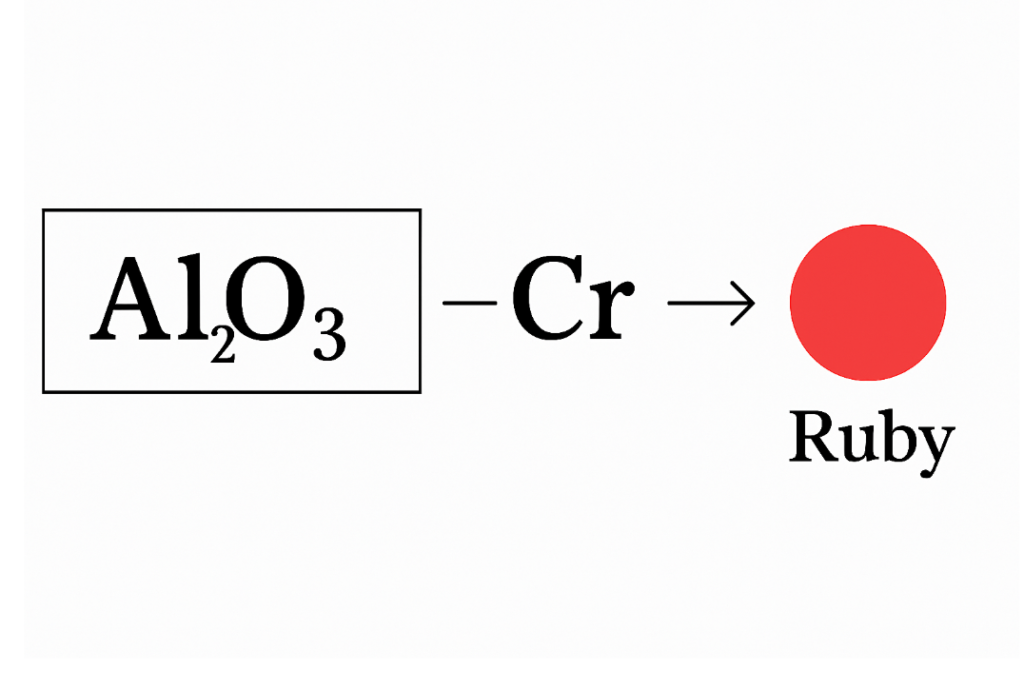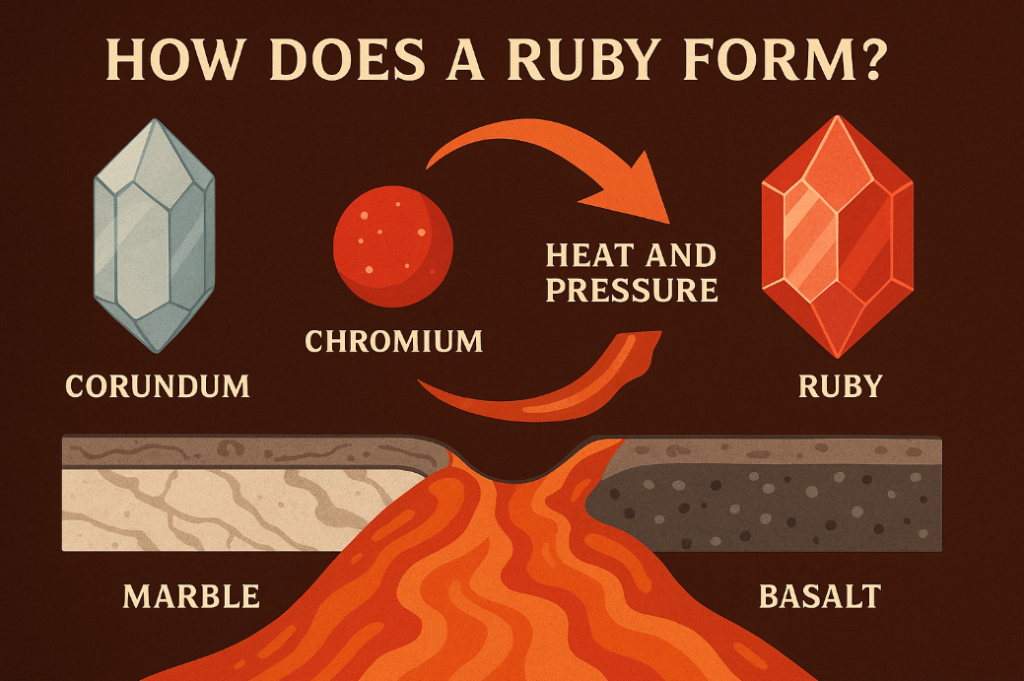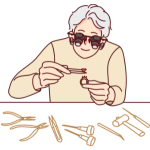Think all red gemstones are rubies? Not quite. Real rubies are rare, expensive, and take millions of years to form under extreme heat and pressure.
They’re a variety of the mineral corundum, just like sapphires—but with one key difference: chromium.
That trace element gives rubies their vivid red hue. In this guide, I’ll walk you through how rubies are made, where they’re found, what affects their quality, and how to tell a natural ruby from a synthetic one.
Whether you’re a buyer, a collector, or just curious, you’ll learn what truly makes a ruby a ruby.
What Is a Ruby Made Of?

A ruby is a gemstone made from corundum, a crystalline form of aluminum oxide (Al₂O₃). Corundum is a mineral that, on its own, is colorless.
But when chromium atoms replace some of the aluminum, the crystal takes on a vivid red hue — that’s when it becomes a ruby. If iron or titanium are present instead, the stone becomes a sapphire.
Rubies and sapphires are chemically identical. The only difference lies in the trace elements. That’s why both are classified as varieties of the mineral corundum.
Here’s a breakdown of ruby’s composition:
| Component | Role |
|---|---|
| Aluminum oxide | Forms the base mineral corundum |
| Chromium | Creates the red coloration |
| Oxygen | Binds with aluminum |
| Trace minerals | May affect tone and fluorescence |
How Long Does It Take for a Ruby to Form?

Ruby gemstones don’t appear overnight. They take millions of years to form deep inside the Earth. The process begins when aluminum oxide starts crystallizing in specific rocks, like metamorphic marble or igneous basalt, under enormous heat and pressure.
For a ruby crystal to appear, the presence of chromium must be just right. This is what gives rubies their red color and separates them from sapphire.
This kind of environment is rare. That’s why good rubies have been found in only a few regions. Even then, not all stones are gem-quality. Many rubies never reach the surface.
Others get damaged or altered. That’s one reason why high-quality rubies are scarce — especially in recent years, when few good rubies have entered the market.
The formation timeline depends on local geology, but generally ranges between 20 and 60 million years. That’s why a natural ruby over one carat, with rich color and minimal flaws, can be an expensive ruby, often priced higher per carat than a diamond.
Rubies are hosted in two main rock types:
- Metamorphic rocks, especially marble
- Igneous rocks, such as basalt
In metamorphic environments, rubies grow in marble that has low iron content. These rubies, often from Mogok in Myanmar, show strong fluorescence and rich red tones.
This is where many of the finest rubies — including the legendary Burmese ruby — come from. Ruby deposits are found here in narrow zones, and the region remains one of the world’s main sources for rubies.
In contrast, igneous-hosted rubies, like those found in Thailand, Mozambique, and Madagascar, are darker and may have more inclusions.
These stones are often treated to improve clarity and color. The application of heat is common and accepted in the industry, especially for rubies at the lower end of the price scale.
The quality of a ruby can depend on the host rock:
- Marble-hosted rubies tend to have better color and fewer imperfections
- Basalt-hosted rubies are more abundant but usually require enhancement
Regardless of the rock type, rubies are made under intense conditions. And that makes them rare among precious gemstones.
Where Are Rubies Found?

Rubies are found in a limited number of places across the globe, but only a few regions produce gem-quality stones. The most famous location is Myanmar, particularly the Mogok Valley.
This area has produced some of the highest quality rubies known, including many stones prized by the International Gem Society and the International Colored Gemstone Association.
Other significant ruby deposits include:
- Mozambique – A major modern supplier of ruby gemstones with good color and size
- Madagascar – Known for producing both ruby and pink sapphire, sometimes in the same mines
- Thailand – A key cutting and treatment hub, though many rubies mined here are heat-treated
- Burma (Myanmar) – Home to the classic Burmese ruby, valued for its saturation and clarity
Here’s a comparison of major ruby-producing regions:
| Country | Region | Notes |
|---|---|---|
| Myanmar | Mogok | Source of the finest rubies, strong red hue |
| Mozambique | Montepuez | Consistent supply, often heat-treated |
| Madagascar | Andilamena | Mixed material: rubies and pink sapphires |
| Thailand | Chanthaburi | Cutting and export center for rubies mined elsewhere |
These ruby deposits vary in output and quality, but they all contribute to the global supply. Rubies are also used in high-end ruby and diamond jewelry, and as the birthstone for July, they remain a symbol of rarity and luxury.
Their value depends on many factors — especially carat weight, color, and clarity — which is why some rubies can cost thousands per carat.
Natural vs. Synthetic Rubies
Ruby is a variety of corundum, and I’ve spent enough time around both natural and lab-created stones to tell you — they’re not the same.
In nature, rubies form under intense heat and pressure over millions of years. That time and geological complexity are part of what makes them so rare — and so valuable.
But we can also create rubies in a lab. These are synthetic rubies. They’re chemically identical to natural ones — aluminum oxide with chromium — but they’re grown fast and in controlled conditions. I’ve seen lab-grown rubies that are flawless and bright, but they don’t carry the same story, or value, as natural gems.
You’ll find synthetic rubies in lasers, watches, and plenty of budget jewelry. They’re useful and affordable, but if you’re after a gem with investment value, natural is the only way to go.

Key Differences
| Feature | Natural Ruby | Synthetic Ruby |
|---|---|---|
| Origin | Formed deep in Earth over millions of years | Made in labs in a matter of weeks |
| Value | High — based on rarity and origin | Lower — mass-produced |
| Inclusions | Often has imperfections | Usually flawless |
| Use | Fine jewelry, collecting, investment | Lasers, watches, entry-level pieces |
When I inspect rubies, I use magnification and spectroscopy — most gem labs do the same.
And while rubies are treated in both cases to improve their look, the origin always affects the final price. A flawless lab ruby might sparkle, but it won’t ever match the market or emotional value of a natural one.
Why Are High-Quality Rubies Rare?

I get asked this a lot: why are fine rubies so hard to find? The answer’s simple — most rubies just don’t meet the mark.
They may be too dark, too included, or too small. Even in legendary locations like Mogok in Myanmar or Mozambique, only a small fraction of what’s mined ends up in high-end jewelry.
In recent years, I’ve seen fewer and fewer good rubies hit the market — especially untreated ones. That scarcity drives prices up fast, especially for stones with strong color, good clarity, and solid carat weight. And trust me, those are rare.
Even when rubies are mined in quantity, only a small number have the right balance — vivid hue, minimal flaws, and the potential to be cut into a brilliant gem.
That’s what makes high-quality rubies so valuable. It’s also why the largest ruby ever found is considered a one-in-a-million discovery. It’s not just size — it’s quality and purity that elevate a ruby from common to collectible.
Common Issues in Rubies:
- Rubies have imperfections such as rutile, cracks, or cloudiness
- Rubies can show uneven color or zoning
- Rubies are commonly heat-treated to improve appearance
Rarity is what turns a stone from common mineral to precious gem.
Common Ruby Treatments
To improve appearance and marketability, many rubies undergo treatment. The most common method is heat treatment, where the stone is exposed to high temperatures to deepen its color or remove internal cloudiness.
Some rubies are filled with lead glass to improve clarity. This method helps rubies at the lower end look cleaner but lowers long-term value. These stones must be disclosed as treated, especially in professional settings like auctions or certification by a gem society.
Typical Ruby Enhancements
| Treatment Type | Purpose | Common In |
|---|---|---|
| Heat treatment | Enhance color, reduce clouds | Thailand, Mozambique |
| Fracture filling | Improve clarity | Lower-quality material |
| Dyeing | Add artificial color | Rare, low-end only |



Leave a Reply